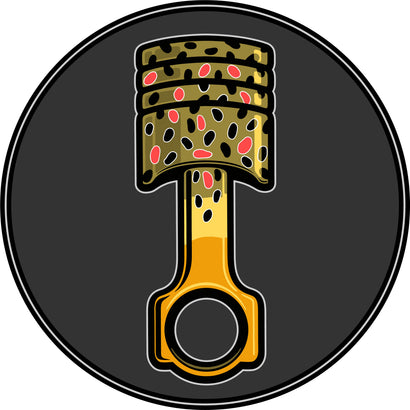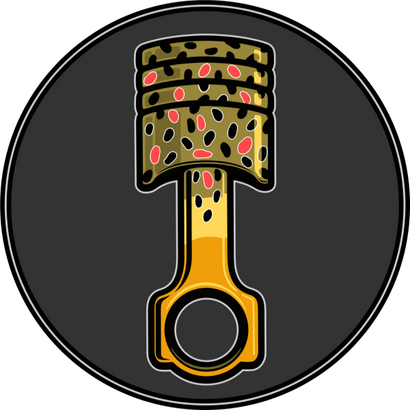Sometime between early March and the end of April is peak season for the Great Lakes steelhead run. We'll show you what flies will catch those fish.
Note: If you are looking for our favorite rods, reels and lines for swinging flies for Great Lakes Steelhead click here
Firstly congratulations! Although this one was quite tame, you made it through another winter. There is so much awesome fishing coming up on the calendar it's almost overwhelming: steelhead, trout, bass, musky, carp... the list goes on!
The mild winter has meant there have been quite a few good days to fish for steelhead. With warming temperatures coming, the fishing is about to go parabolic, so lets dive in on our top picks for spring steelhead flies.
Top Picks for Swung Flies
If we had to pick one color combination to fish for the rest of our lives we would pick black and copper. Why black and copper? Black seems the best foundation steelhead color. It goes with almost every other color and steelhead just flat out love it.
As for copper, we love it for quite a few reasons. It's a dark color, like black but still has a pop to it which makes it contrast well with black. It's also a rare dark yet unnatural color. We don't know of any fish or insects that are copper colored which makes it something that the fish don't see much. The last reason is that we love synthetic materials and it's a color that is only available as a synthetic.
With that being said, meet Doctor Copper:

Doctor Copper has a long black synthetic wing above copper flash and hackle. It comes unweighted or weighted with dumbbell eyes. We like fishing the weighted version in smaller rivers like the Clinton where getting the fly into the zone quickly is important. For larger rivers like the Muskegon, go with unweighted unless the water is really high or cold.
Senyo's Aqua Scandi
Like our previous fly, the Aqua Scandi is a temple dog-style steelhead fly, but with a mix of synthetic and natural materials. The key components of this fly are the high-grade marabou, krystal flash, synthetic jungle cock eyes and vibrant front hackle of guinea feather.

These flies are meticulously tied and are just beautiful. They come in a 5 colors and are all unweighted.
One product we have found useful recently is
Loon Outdoors Deep Soft Weight. It is tungsten-based, reusable and non-toxic weight that is easily applied to your leader. What we really like about this stuff is that it won't kink or damage your leader when you apply it and you can use as much or little as you want. Deep Soft Weight can be great to add to unweighted flies like those the Aqua Scandis above.
Spiced Hungarian

Simple, unpretentious and effective in low water, the Spiced Hungarian is a workhorse fly for great lakes steelhead. Similar to Doctor Copper, it has a long black synthetic wing with a small amount of flash on top. The body is minimal so it sinks quickly and does well with spooky steelhead.

The weighted version comes with dumbbell eyes and an orange dubbed head. What steelhead doesn't love orange?
Great Lakes Steelhead Egg Flies
Fact: Steelhead love eggs. They love to eat salmon eggs in the fall, they love to eat other steelhead eggs in the spring. Steelhead love eggs.

Our egg patterns are simple, effective and pretty damn cheap. They do all the things an egg pattern is suppose to do: they look like real eggs, and they are tied on 2X strong hooks. That 2nd point is especially important.

Steelhead are not like resident trout. They are big, tough and mean. If you fish on trout hooks for steelhead you will eventually bend open your hook on that fish of a lifetime. Many of the cheap internet eggs are tied on lousy trout hooks, and ours are not.

Great Lakes Steelhead Nymph Patterns
One of our favorite steelhead nymphs is Nymick's Sassy Steelhead nymph. It runs on the smaller size and is more drab than many other steelhead nymphs, which means it does well when water is low and clear or steelhead have seen a lot of pressure. It's natural colors make it look closer to a trout nymph than a standard steelhead nymph. Olive is our top choice for most conditions but get a few pink just in case.

On the other end of the spectrum is the Hot Spot Stone Fly. This is a large, flashy steelhead nymph. It's impossible to have a steelhead nymph box and not a handful of these in both Chartreuse and Fluorescent Pink. These flies excel in high, dirty water which is very common in the Spring season.


The most common fly fishing nymph and egg set up for Great Lakes Steelhead is a double rig: a nymph tied on to the leader and an egg pattern tied on below the nymph fly. This can be done a few different ways.
You can tie tippet from the first fly's hook bend to the 2nd fly. You can also use Tippet Rings. Tie your leader to the tippet ring, then run 2 different lengths of tippet off the ring for the flies. Tippet rings create a strong connection between your leader and tippet, that don’t require you to cut back your leader every time you need to add additional tippet. You can also use a swivel, which has similiar results, but has the added benefit of preventing your line from twisting up with a complex double rig.
















